#the spirit of new orleans
Photo
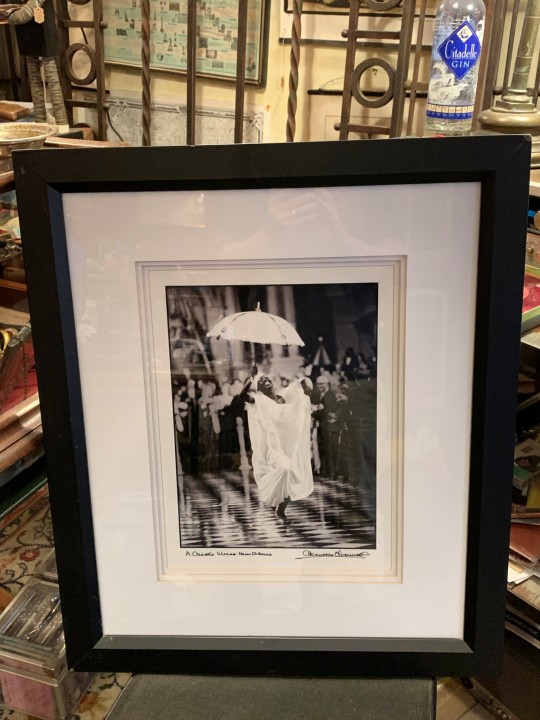




A CREOLE MASS by HERMAN LEONARD
A Creole Mass also known as The Spirit of New Orleans , an image by photographer Herman Leonard ( 1923-2010 ) one of the most iconic images captured by Leonard on his New Orleans period. It captures Michelle Gibson dancing during the performance of “A Creole Mass “ , composed by Wardell Quezergue and performed at the St Louis Cathedral in 2001.
Framed , titled and signed print
Item No. E5686
Dimensions: 28” x 23” (frame )
SOLD
504.581.3733 / tel
#photography#art photography#herman leonard#new orleans#st louis cathedral#the spirit of new orleans#a creole mass#wall decor#magazine street
8 notes
·
View notes
Text
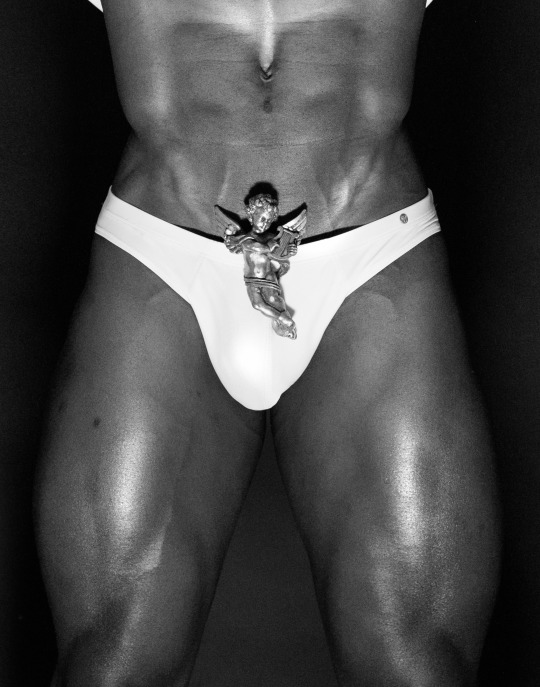
Voodoo- Hamidou Banor by Baldovino Barani for FACTORY Fanzine XXXVI
#rufskin#angel#cherub#baroque#harp#hamidou banor#hamidiu banor#baldovino barani#voodoo#vaudou#factoryfanzine#voodoo priest#new orleans#magik#spirits#offerings#french quarter#muscle#beauty#supermodel#baron samedi
626 notes
·
View notes
Text
I haven’t listened to songs about trains in a while… in too long… maybe that will fix me
#I was reminded of the spirit of New Orleans#when I was a kid I had some cds of folk and country songs about trains#there’s a lot of good ones and like the rhythm of a train works soooo well with music
45 notes
·
View notes
Text
Ogou Or Ogun. Spirits Of Iron In African Diaspora.
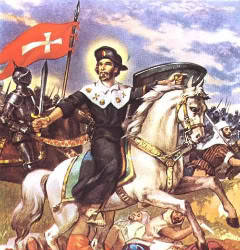
This is Papa Ogou one of many in the Ogou nation.
Ogou is a Nago spirit from the Nago Nation these spirits came to Haiti from Africa. they are strong spirits and used with the Asson or Tcha Tcha (rattle) there personality falls between Rada and Petro.
Now some might think, " Isn’t there a spirit like this in Lukumi ? ” Yes. There is, He is Ogun an Orisha. One of few Orishas who made it outside of Africa and who has some similarities with Ogou: In Haitian Vodou and Santeria and so on. They both are associated with iron and metal. Ogun is more of a blacksmith, whereas Ogou is more of a soldier.
When you hold a knife, railroad spike, sword or horseshoe in your hand and you're holding Ogun or Ogou. Ogun is also the patron of anyone who works with metal.
This spirit is great even if your practicing hoodoo because he can protect you help you even help increase your energy in your workings.
There are also many Ogous in Haiti, like Ogou Kriminel, Ogou La Flambeau, Ogou Feray, Ogou Badagris, Ogou Shango, to name a few. He is also associated with a particular region of Nigeria, and is often depicted as an older soldier there names in Cuban Santeria (La Regla Lucumi) he is known as Ogun, or Oggun; In Brazilian Candomble.
The name Ogou is not a name like in Africa but is actually a title used to describe warriors and they also carry a machete, but some favor a sword. There colors are red and blue, but some Ogous take additional colors like green or khaki. Remember: if you can’t afford anything other color to wear, you can always use a (white scarf to salute any spirit.)
Ogoun Ferraille, aka Papa Ogou Feray in New Orleans, this warrior lwa is the primary figure of Saint James the Greater—the saint himself riding into battle on a white horse. He is also represented by the Archangel St. Michael, and Saints Andrew, Martin Caballero, some use Saint Peter and John the Baptist any many others depending on which African diasporic religion you want to practice.
He is the chief of all the warrior paths of Ogun durning the Haitian revolution which gave the colors to the Haitian flag.

Orisha Ogun
INVOKED:
Ogun or Ogou is invoked to heal diseases affecting blood, including AIDS, leukemia, and sickle-cell anemia. He is invoked for safety and success before surgery. He also heals infertility and erectile dysfunction. Request his protection from crime and criminals. He also help finds employment for devotees.
Ogou is usually syncretized to Saint James the Greater but may also be associated with Michael Archangel and Saints Andrew, any many others depending on which African diasporic religion you want to practice.
He is a works tirelessly at the forge, in the bedroom, and on behalf of his devotees. He never rests.
He will use his machete to cut away all evil and sweep your enemies away. But he is also a tender and loving Papa. I’ve will cry when his children are in pain. Ogou also loves the ladies and he is one of the most commonly married lwa.
ATTRIBUTES: A machete, a three-legged iron cauldron, traditionally wrapped in chains and filled with iron implements, including tools, spikes, nails, and knives👇
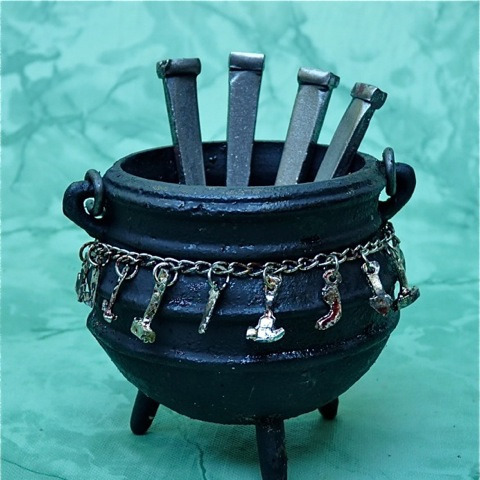
SPIRIT COLOURS: Red, black, sometimes green, sometimes red and white (the colors of heated iron), or blue and red (the colors of the Haitian flag) or Green and black for Ogun. But can always wear white if you don't have the other colors.
OFFERINGS: Red candles, cigars, rum, whisky, aguardiente, or other alcoholic beverage— incense, metal, chains, metal tools, railroad spikes. He likes red beans and rice, and typically likes Florida water as a cologne.
Fill a cauldron with found pieces of metal, like rails or railroad spike (not plastic).
He will often blow cigar smoke on people to give them blessings.
So whichever one you're drawn to like Haitian or African spirits, there's no spirit better to have for protecting than Ogun. Except, St. Michael or God of course 😃
Everyone needs a warrior. Ogun is his name among the Yoruba people. Among the Fon he is called Gu. In Cuban Santeria (La Regla Lucumi) he is known as Ogun, or Oggun; In Brazilian Candomble , Ogum; in Haiti’s Vodou and New Orleans Voodoo Papa Ogou, or simply Ogou.
Feast Day: He is syncretized with St. Peter whose feast day is June 29, St. James whose feast is July 25th, and St. Michael whose feast is Sept. 29th.
#Haitian Vodou Lwa#African spirit Ogun#Law Ogou#Spirits#Haitian Vodou#New Orleans Voodoo#Lwa & Saint connection#spiritual#google search#rootwork#Southern voodoo#like and/or reblog!#follow my blog#Google search
13 notes
·
View notes
Text
Many Validate The Claim That 'Jackson Square' In New Orleans' French Quarter Is HAUNTED
I was there on New Year's and I was also there on Halloween same year. And I can tell you that you hear all sorts of things and it's not The River.
3 notes
·
View notes
Text
Very funny to think at the same time the supernaturals of New Orleans are bickering about who should be in charge and how to get more power, the Mystic Falls lot are fighting against the literal unravelling of all magic in the world
#TVDu#tvd lb#series 5#Promised Land#like series 5 of tvd canonically is occuring at the same time as series 1 of the originals#so while the witches of new orleans are trying to sacrifice each other for more power so they dont lose their magic#a couple hundred miles north magic is being unravelled potentially for good#like thats the travellers whole plan is to rid the world of spirit magic in its entirety#klaus had already been in contact with Bonnie to learn that the other side was falling apart#so they know that something massive is going down for the supernatural world but that doesnt stop theyre territorial squabbling#its just if the witches know about hope and klaus becoming hybrid like even the ones that werent there know cus they can sense the nexus 40#or whatever shouldnt the witches of new orleans be aware that the other side os falling apart? the magic itself is danger?#it doesnt matter that youre about to lose access to the ancestral well when all spirit magic is about to be eradicated#just wouldve been a very different series 2 of the originals if they hadnt managed to stop the anti magic spell before it got to nola
3 notes
·
View notes
Photo

INSTAGRAM: catlandbooks
Throughout Africa and beyond in the diaspora caused by the slave trade, the divine feminine was revered in the forms of goddesses like the ancient Nana Buluku, water spirits like Yemaya, Oshun, and Mami Wata, and the warrior Oya. The power of these goddesses and spirit beings has taken root in the West. New Orleans, for example, is the home of Marie Laveau, who used her magical powers to become the “Voodoo Queen” of New Orleans.
Author Lilith Dorsey shows us in Orishas, Goddesses, and Voodoo Queens how to celebrate and cultivate the traits of these goddesses, drawing upon their strengths to empower your own life. In addition to offering a guided tour of the key goddesses of the African religious traditions, the book offers magical spells, rituals, potions, astrological correspondences, sacred offerings, and much more to help guide you on your own transformational journey.
——
New Orleans has long been America’s most magical city, inhabited by a fascinating visible and invisible world, full of mysteries, known for its decadence and haunted by its spirits. If Salem, Massachusetts, is famous for its persecution of witches, New Orleans is celebrated for its embrace of the magical, mystical, and paranormal. New Orleans is acclaimed for its witches, ghosts, and vampires. Because of its unique history, New Orleans is the historical stronghold of traditional African religions and spirituality in the US. No other city worldwide is as associated with Vodou as New Orleans.
There is a mysterious spiritual underbelly hiding in plain sight in New Orleans, and in this book Alvarado shows us where it is and who the characters are. She tells where they come from and how they persist and manifest today. Witch Queens, Voodoo Spirits, and Hoodoo Saints shines a light on notable spirits and folk saints such as Papa Legba, Annie Christmas, Black Hawk, African-American culture hero Jean St. Malo, St. Expedite, plague saint Roch, and, of course, the mother and father of New Orleans Voudou, Marie Laveau and Doctor John Montenée.
#new orleans#witch#witchery#witchcraft 101#Marie Laveau#Annie Christmas#vodou#salem#salem massachusetts#vampires#spirits#espiritualidad#espiritismo#ritual#Yemaya#Oshun#Orishas#Oya#goddess#goddesses#saints
92 notes
·
View notes
Text


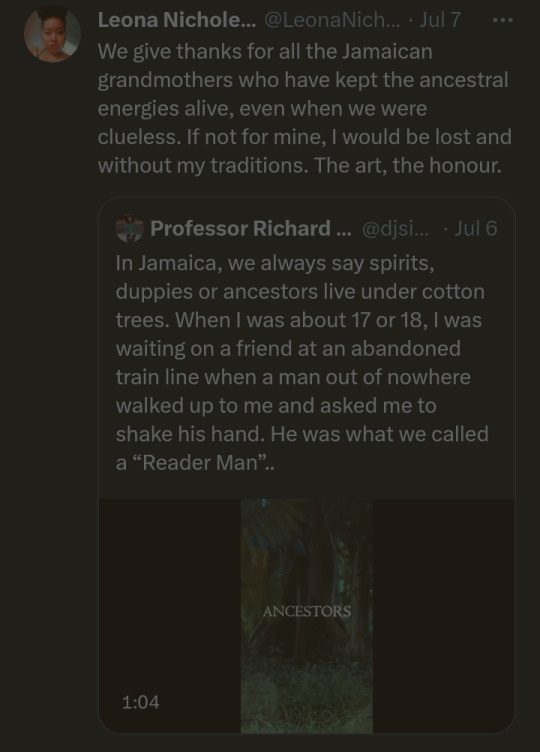
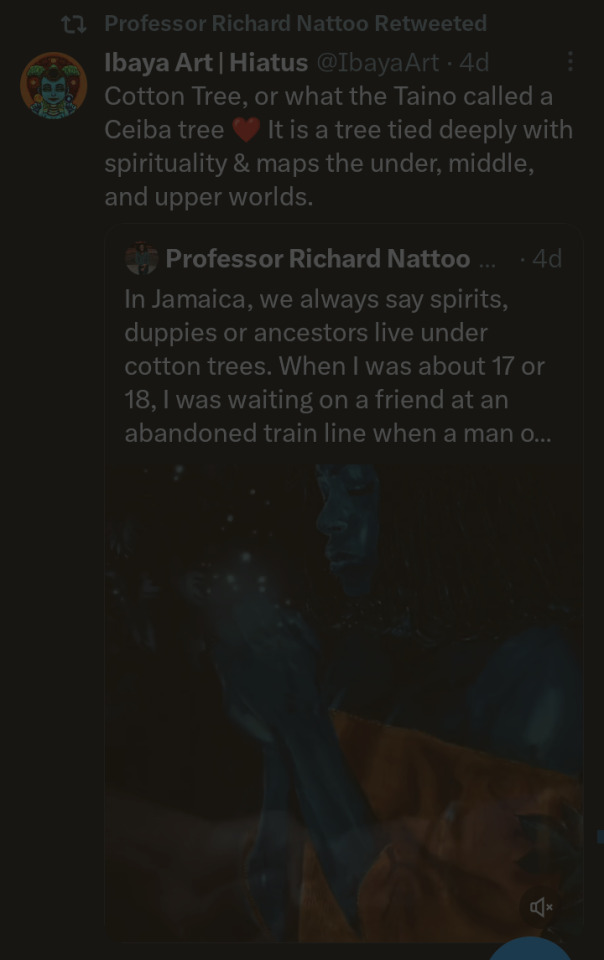

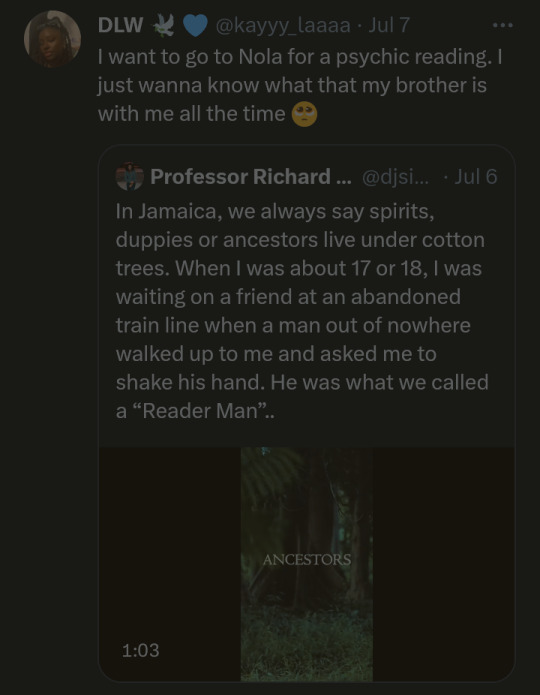
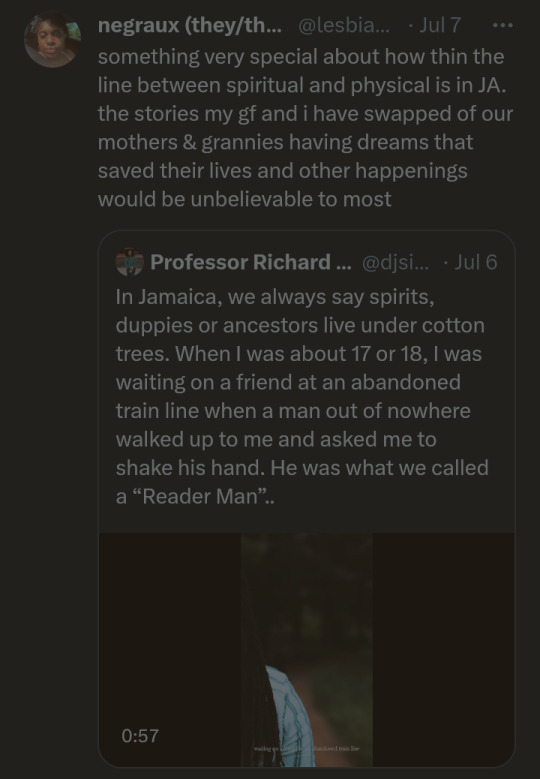
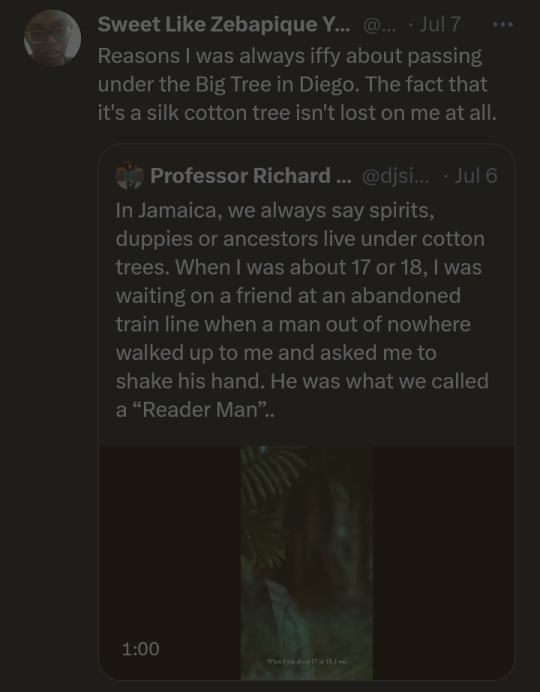

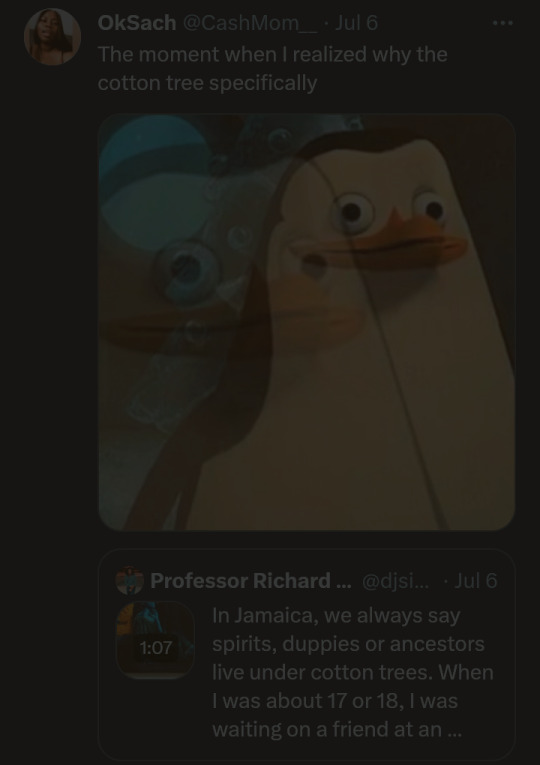
#jamaica#spirituality#spirits#duppies#art#caribbean creatives#trinidad & tobago#haiti#guyana#new orleans#american south#dominican republic#cotton trees#black sprituality#taino sprituality#ceiba tree#silk cotton tree#gullah geechee#fireflies#professor richard nattoo#jamaican creatives#jamaican artist
3 notes
·
View notes
Text
THE HAUNTED BAR THAT’S BEEN AROUND SINCE BEFORE LOUISIANA WAS EVEN A STATE

Lafitte’s Blacksmith Shop is the oldest building in the country being used as a bar. This famous little watering hole on Bourbon Street was once believed to be the headquarters for the infamous Lafitte brother’s illegal smuggling operation, and many believe that Jean Lafitte still frequents the bar. He is often seen standing in a dark corner, gazing out at the patrons. When your eyes meet, he will vanish into thin air, making you question whether or not you should finish your drink. That’s not all though, as many have claimed to have seen a pair of glowing red eyes appear in the fireplace, leading some to believe that there’s a much darker, sinister type of energy here as well. So the next time you find yourself at this bar and you think you see something, don’t be so quick to blame it on those cocktails.
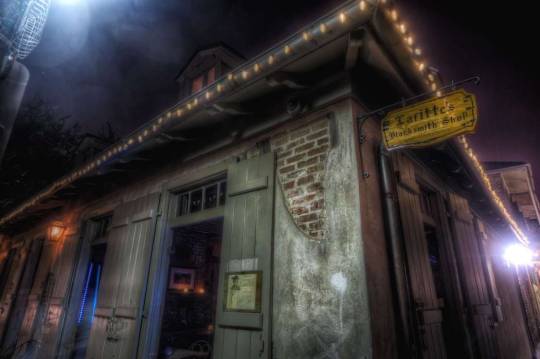


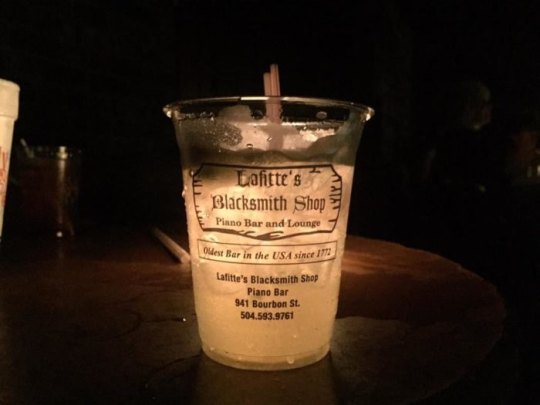
Built between 1722 and 1732 by Nicolas Touze, is reputed to be the oldest structure used as a bar in the United States. In 1722, further building is recorded by a realty transfer set down by one Don Andres Almonester. The structure and fence are in the old French Provincial Louis XV or Briquette-Entre-Poteauxe style used in French Louisiana. The building escaped two great fires at the turn of the 19th Century, due to slate roofing. Such slates are presently used by artists as canvases. Between 1772 and 1791, the property is believed to have been used by the Lafitte Brothers, Jean and Pierre as a New Orleans base for their Barataria smuggling operation.

The legend is based on the fact that the property was owned by the family of Simon Duroche a.k.a. Castillon and the wily privateer Captain Rene Beluche. Castillon was a rather record-shy adventurer and entrepreneur. Captain Beluche commanded his ship "Spy" in Lafitte's Baratarian fleet. Although the owners of the property, Jean Baptiste Dominica Joly LaPorte probably lived on the premises, it is within reason that the Lafittes could have used the place as city base for negotiations with potential buyers of their goods. It is unlikely that a wealthy Creole would agree to meet at home on Royal Street. Bourbon and St. Phillip was probably regarded as a safe and convenient neutral ground. Like most New Orleans legends, Lafitte's Blacksmith Shop is a gumbo of truth and French, Spanish, African, Cajun and American embellishments.



Address: 941 Bourbon St., New Orleans, LA 70116

#these haunted hills#Lafitte Blacksmith Shop#new orleans#ghostcore#ghost and hauntings#haunted#ghost and spirits#real ghost photos#haunting#ghost#haunted places
29 notes
·
View notes
Text





[IT'S A NEIGHBORHOOD RESTAURANT, AND THAT'S HOW IT FEELS. OH, YEAH. GRITS AND GRILLADES, SCOTTIE SPECIAL UP! TO COME BACK TO SOME PLACE BUT PEOPLE STILL THINK WHAT YOU LOOK LIKE IS WHO YOU ARE. THAT'S THE SPIRIT OF THE FOLKS OF NEW ORLEANS IS THAT YOU GUYS REBUILT YOURSELVES.]
#s11e10 fully loaded#guy fieri#guyfieri#diners drive-ins and dives#neighborhood restaurant#new orleans#oh#yeah.#grits#grillades#scottie#some#place#people#spirit#folks
3 notes
·
View notes
Text
Wake up with pure J O Y 🔅🌴
#hippie#plants#nature#freedom#new orleans#nola#nostalgia#home & lifestyle#home#love#dancing#free spirit#freespirit#afrobeats#reggae#selfcare#new#carefree#sonday
3 notes
·
View notes
Text

Voodoo- Hamidou Banor by Baldovino Barani for FACTORY Fanzine XXXVI
#rufskin#hamidou banor#hamidiu banor#baldovino barani#voodoo#vaudou#factoryfanzine#voodoo priest#new orleans#magik#spirits#offerings#french quarter#muscle#beauty#supermodel#baron samedi
657 notes
·
View notes
Text
character
She’s the cemeteries down in New Orleans
the clawfoot bath with 1930’s charm
the crocheted blanket over the couch
the wild onions sprouting in the yard
She’s the damp wood crackling in the bonfire
the broken stained-glass Tiffany lamp
the thrifted velvet window curtains
the moving hips to a sultry dance
She’s the penny taped to your turn table needle
the sun’s heat through dark fabric
the crinkles on an old band poster
the first time you ever felt magic
a.b.
#main character#new orleans#magic#1930s aesthetic#1930s#cemetery#lafayette#band poster#poems#poetry#how i love being a woman#woman#women#i love women#free spirit#original poems#my poem#spilled poetry#stained glass#tiffany lamp#crocheted#crochet#crochet blanket
6 notes
·
View notes
Text
VODOU LWA/ VOODOO SPIRITS AND CATHOLIC SAINT COUNTERPARTS
The Vodou Lwa, Voodoo Spirits and their Catholic Saint counterparts.
Why were the Vodou Lwa Synchronized? They became syncretized when the spirits they came to the new world and found it's way too the New Orleans Voodoo tradition by the Haitian Vodou religion? Since Louisiana was primarily Catholic need to protect their practice it made sense to add the spirits with the Catholic Saints. These are the most common Catholic Saints traditionally associated with the Vodou spirits. (All photos from Erzulie’s Voodoo in New Orleans.)
The following overview of the Voodoo spirits and their Catholic counterparts are not intended to replace the history. Instead, this is to provide a general concepts as to which Catholic Saints the Vodou Lwa are most closely associated with due to the African diaspora (slave trade)
Voodoo and the Catholic Saints:
In New Orleans, many traditional Voodoo altars are decorated with Catholic saints. This is because, to avoid persecution, many practitioners would syncretized the Lwa and Orisha with their saints. This practice has also led to the incorrect belief that Voodoo is descended from Catholicism, even though the African religions it is based on predate Christianity by thousands of years. Here are some of the more sought after and renowned Vodou Lwa/spirit and their Catholic Saint counterparts for you to use. Spells and Rituals. Here are a few from Haitian, New Orleans, Puerto Rican spirituality) or 21 Divisiones with their saints.

Papa Legba, the Divine Messenger and Road Opening, Saint Counterpart St. Peter.

Papa Legba, the Divine Messenger and Road Opening, Saint Counterpart St. Lazarus. (Haitian, )

Papa Legba, the Divine Messenger and Road Opening, Saint Counterpart St. Anthony. (New Orleans, Haitian)
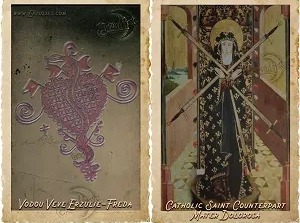
Erzulie-Freda, the Lwa of Love & Passion. Saint Counterpart Mater Dolorosa.
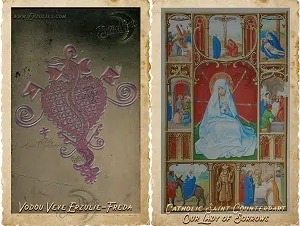
Erzulie-Freda, the Lwa of Love & Passion. Saint Counterpart Our Lady of Sorrows.
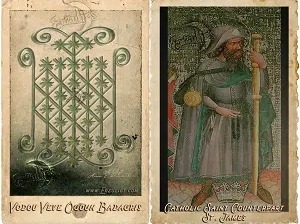
Ogoun Badagris, the Warrior Spirit. Saint Counterpart St. James.

Ogoun Balendjo, the Warrior Spirit. Saint Counterpart St. Philip.

Ogoun Feray, the Warrior Spirit. Saint Counterpart St.

Agwe, Sovereign of the Sea. Saint Counterpart St. Ulric.
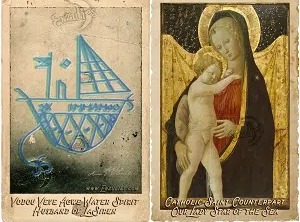
LaSiren, Divine Water Spirit, wife of Agwe, Sovereign of the Sea. Saint Counterpart Our Lady Star.

Ayizan, the Priestess. Saint Counterpart St. Lucy.
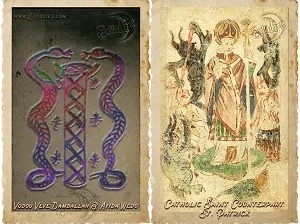
Lwa Damballah, the Father Lwa and wife, Ayida-Wedo. Saint Counterpart St. Patrick.

Erzulie-Dantor, the Great Mother Lwa. Saint Counterpart Our Lady.
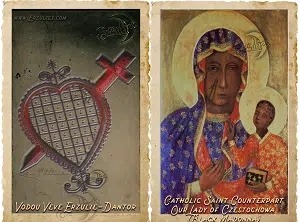
Erzulie-Dantor, the Great Mother Lwa. Saint Counterpart Our Lady of Czestochowa (the Black Madonna)
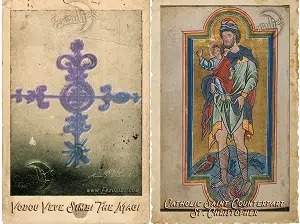
Lwa Simbi, the Magi. Saint Counterpart St. Christopher.
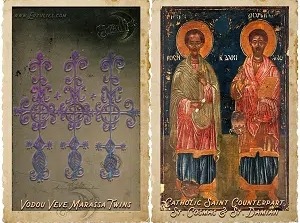
Lwa Marassa, the Divine Twin. Saint Counterpart St. Cosmas & St. Damian.
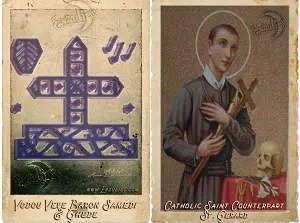
Baron Samedi and the Ghede. Saint Counterpart St. Gerard.
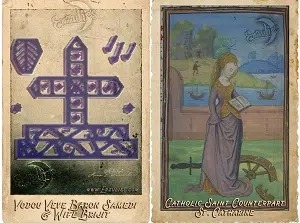
Manman Bridgette and the Ghede. Saint Counterpart St. Catherine.
I sincerely hope you enjoyed this introduction on the Vodou Lwa, Voodoo Spirits and their Catholic Saint Counterparts.
#Vodou Lwa#Voodoo spirits#Catholic saints#Law/ saint's#Spiritual#Haitian#New Orleans#Traditional#Spirits#God's.
22 notes
·
View notes
Text


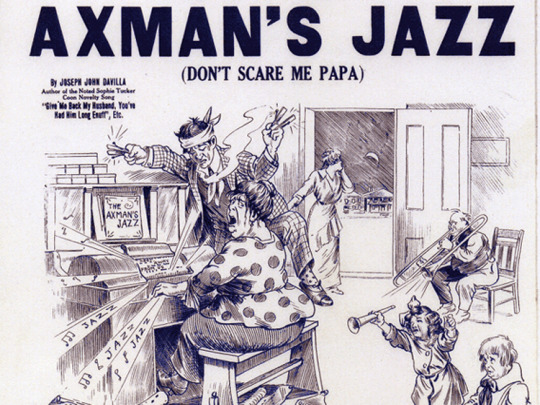
The Strange Mystery of the Axeman of New Orleans Murders
An axe-wielding maniac stalked the streets of the Big Easy, and the only way to avoid slaughter was to play jazz.
It was the night of March 19, 1919 and jazz played in New Orleans.
Music poured out of private residences, where wealthy white New Orleanians hired bands to play music popularized in a mixed race Red Light District. Yet the musicians weren’t playing for love or money. These concerts were borne of fear, ordered by an axe-wielding maniac who claimed to come straight from Hell.
For almost a year, the city of New Orleans had been the subject of multiple attacks by a serial killer, an axe murderer who to this day has never been identified. The mysterious figure is known to history as the Axeman of New Orleans. While it is impossible to verify whether he’s responsible for all of the murders ascribed to him, it is a fact that from May of 1918 until October of 1919, 12 people were attacked across greater New Orleans, seven of whom died from their brutal wounds.
In almost every case, a small hole was carved out of a door. The Axeman would crawl through this opening so small that several suspects were dismissed on account of their size and then bludgeon his victims with an axe. Curiously, the weapon employed was often in the house, and left at the scene of the crime along with the chisel used for breaking through the door.
The victims of the Axeman had qualities in common. They were mainly women. Men only suffered blows if they got in the Axeman’s way and never seemed to be the primary target. Many of the victims were Italian Americans, who at the time represented white underclass.
Citizens of Italian descent were no strangers to violence in New Orleans. In a city troubled by its tense race relations, the largest mass lynching in civic history was of 11 Italian Americans outside Parish Prison in 1891. Italians and their descendants lived in crowded slums that lacked the law enforcement presence of other neighborhoods. Many assumed Italian neighborhoods were run by mafia organizations like the Black Hand.
Into this volatile mix stepped the Axeman. His first officially recognized murder was on May 22, 1918. On that late spring day, he used his chisel to remove part of a door and slip into the home of Joseph and Catherine Maggio. When Joseph’s brothers Jake and Andrew, who also lived in the home, went to check on the couple, they found Catherine’s corpse draped over Joseph, whose head and face were gashed. Joseph reacted to the appearance of his brothers, but died from his wounds shortly thereafter. Catherine’s head had almost detached from her body. Her killer had used Andrew’s straight razor to slit her throat so deeply that she had been practically decapitated.
Andrew Maggio was arrested for the attack but released after an investigation turned up no further evidence linking him the crime. What police did find, about a block from the Maggio house, was a message scrawled in chalk which read, “Mrs. Maggio will sit up tonight just like Mrs. Toney”.
Over the long hot summer that followed, two more attacks yielded four more victims, two of whom died from their wounds. One victim who survived, a Polish immigrant named Louis Besumer. This led to speculation that the attacker was a gangster bent on extortion but if he was affiliated with organized crime, he seemed strangely nonchalant about money. The Axeman’s victims rarely had their values taken.
A strange lull then settled over New Orleans as the summer dragged on. From August 10, 1918, until late winter of 1919, no attacks were reported. Then, on March 10, 1919, in the suburb of Gretna just across the river from New Orleans proper, tragedy struck. The Cortimiglia family. Charles, Rosie and two-year old Mary were attacked in their home after an invader carved out part of their kitchen door. Rosie, found cradling her dead daughter in her arms, was the only survivor.
Fear tightened its grip on New Orleans once again. Three days after the Cortimiglia attack, an ominous letter arrived at local newspapers. The author demanded its publication. The address line, in an eerie echo of Jack the Ripper’s correspondence, was from Hell.
Hell, March 13, 1919
Esteemed Mortal:
They have never caught me and they never will. They have never seen me, for I am invisible, even as the ether that surrounds your earth. I am not a human being, but a spirit and a demon from the hottest hell. I am what you Orleanians and your foolish police call the Axeman.
The writer went on to threaten additional murders, claiming he’d leave no clue except for his bloody axe, smeared with the gore of his victims. Then he offered the terrified citizen of New Orleans a proposition.
Now, to be exact, at 12:15 (earthly time) on next Tuesday night, I am going to pass over New Orleans. In my infinite mercy, I am going to make a little proposition to you people. Here it is:
I am very fond of jazz music, and I swear by all the devils in the nether regions that every person shall be spared in whose home a jazz band is in full swing at the time I have just mentioned. If everyone has a jazz band going, well, then, so much the better for you people. One thing is certain and that is that some of your people who do not jazz it on Tuesday night (if there be any) will get the axe.
It is impossible to know whether the Axeman truly wrote this letter. Nevertheless, New Orleanians took the demand to heart. On March 19, the city resounded with jazz. No attack came that evening.
But the bloodletting wasn’t over quite yet. Three more victims, including one fatality, followed in August, September, and October of 1919. After October, the Axeman murders ceased, though there’s speculation that the killer may have struck earlier in the decade, around 1911 or 1912.
The Axeman murders remain a mystery. The grisly details of the case echo through the years, like the swinging jazz that played on that terrifying night in New Orleans.
#The Strange Mystery of the Axeman of New Orleans Murders#unsolved mystery#ghost and hauntings#paranormal#ghost and spirits#haunted salem#myhauntedsalem
6 notes
·
View notes
Text
It's favorite movie character day for our spirit week. Obviously gotta end it with a bang!



#we had a whole spirit week#i even got to wear my mardigras mask from New Orleans#but these are reallt the only photos i have for this week#starshine rambles
1 note
·
View note